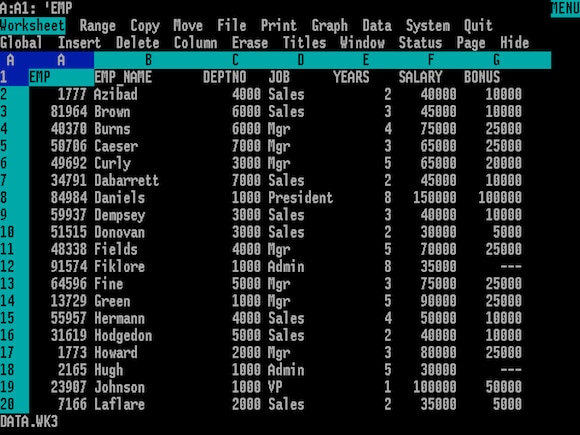 In the 30 years since the introduction of Lotus 1-2-3 very little seems to have happened when it comes to how spreadsheets look and work. When it launched on January 26, 1983, Lotus 1-2-3 was not the first spreadsheet; that title goes to VisiCalc. But since it became the killer app of the first IBM PC, it certainly ranks as one of the most important pieces of software ever. We connected with the developer of Lotus 1-2-3, Jonathan Sachs, to get his take on spreadsheets and the last three decades. Read on for the complete interview.
In the 30 years since the introduction of Lotus 1-2-3 very little seems to have happened when it comes to how spreadsheets look and work. When it launched on January 26, 1983, Lotus 1-2-3 was not the first spreadsheet; that title goes to VisiCalc. But since it became the killer app of the first IBM PC, it certainly ranks as one of the most important pieces of software ever. We connected with the developer of Lotus 1-2-3, Jonathan Sachs, to get his take on spreadsheets and the last three decades. Read on for the complete interview.
Brief Lotus 1-2-3 history
Sachs started programming in FORTRAN during his studies at MIT in the 1960s. He joined Data General in 1977 and co-founded Concentric Data Systems in 1979, where he developed a spreadsheet program inspired by VisiCalc. In 1982, Sachs left Concentric and joined Mitch Kapor to found Lotus Development Corporation.
Lotus 1-2-3 started out as an application written in C, which ran on an Apple II with CP/M card. Then, one day, a PC appeared in the Lotus office, and the decision was made to recode Lotus 1-2-3 in assembly language for the IBM computer. Sachs has said that the source code for Lotus 1-2-3 “was a stack of paper about 8-10 inches high,” and that the compiled code was 85 kb consisting of around 16,000 instructions.
Sachs left Lotus in 1985 and now develops software for his own company, Digital Light & Color, founded in 1993. Its flagship product is Picture Window, an electric darkroom software for serious photographers.
Arguably the best know spreadsheet application today, Microsoft Excel, made its debut for the Apple Macintosh in 1985. Lotus 1-2-3 is still available from IBM.

Lotus 1-2-3 DOS version screenshot courtesy of Wikipedia.
Interview with Jonathan Sachs
Q: You have said before that spreadsheets is a mature technology, one that hasn’t fundamentally changed that much over the years. If you would pinpoint a few things that have actually changed in spreadsheets, from the first Lotus 1-2-3 to the most recent applications like Microsoft’s Excel, what would they be?
A: The original version of 1-2-3 ran under MS-DOS and did not have a graphical interface. It was tuned to the IBM PC, which came with an 80-character by 25-line screen (used to display spreadsheets) and could optionally also support a second monitor for graphics (used to display graphs). Soon after the introduction of the IBM PC, a company named Hercules came out with a display card that let you combine both the text display and the graphics display on a single monitor. The biggest change since those days is the switch to graphical user interfaces such as Windows and the Mac OS, along with the additional formatting options such as multiple fonts, font sizes, and so on. While there have been various new features such as new functions in formulas and plug-ins to perform specialized functions, my guess is that most users – as with word processors – use a small subset of the available features. Most if not all of the major improvements were made years ago – reading up on what’s new in the latest versions of Excel reveals little innovation.
Q: It’s been a while now since you’ve been actively involved in developing spreadsheet software. Have you had any thoughts on how you would innovate the field if you came back into it today?
A: Something I always wanted to do was to graft a programming language onto a spreadsheet so that new functions such as statistical analysis, regression analysis, etc. could be developed and extended by users who had the necessary programming ability. Similarly, user programmable formats would be a nice feature.
Q: The Internet, at least not as we know it and use it today, didn’t exist when you developed Lotus 1-2-3. If it had, how do you think that would have made things different for the product and your work?
A: The impact of the Internet on spreadsheets is mostly that you can email them or share them more easily. Collaborating by having several people working on the same spreadsheet at once does not make a lot of sense. Functions that download data from the Internet into a spreadsheet would definitely be useful for some applications.
Q: And finally, for someone who wants to get into software development today, what advice do you have for them to get started?
A: Having read Outliers by Malcolm Gladwell, my advice is to put in the 10,000 hours of practice it takes to excel at anything. It is also important to study examples of good programming and debugging techniques of experienced programmers.
I was very lucky in that I was able to get a very wide range of experience in mathematics, scientific programming, computer language development, word processing, programming in assembly language and writing operating systems while working for 10 years at MIT and later 2 years at Data General. This experience prepared me for writing spreadsheets and more recently photo image processing software. It is much harder today to get that kind of broad experience, but try not to spend too much time working in a narrow specialty.
What’s next for spreadsheets?
There doesn’t seem to be any doubt that we’ll have to live with spreadsheets on our computers and other devices for quite some time yet. And why should we want them to go away? Spreadsheets are, after all, incredibly powerful tools for certain types of tasks. It may be that the very thought of a spreadsheet sends shivers down your spine, but there’s no denying that many of us rely on them to get things done.
Do you have some amazing ideas for how spreadsheets should change? Perhaps you’re working on some exciting new project right now. Let us know in the comments below or connect with us on Twitter – we’d like to know what you’re up to.
We’d like to finish by saying a big thank you to Jonathan Sachs for taking the time out to talk to us for this interview.
Image (top) via Shutterstock.



























